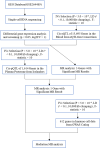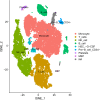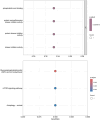Elevated CD14 in B cells associates with reduced ovarian cancer risk via CD80 + dendritic cell interaction: a multi-omics study
- PMID: 40517355
- PMCID: PMC12167730
- DOI: 10.1007/s12672-025-02956-8
Elevated CD14 in B cells associates with reduced ovarian cancer risk via CD80 + dendritic cell interaction: a multi-omics study
Abstract
Introduction: Ovarian cancer (OC) is a highly aggressive malignancy characterized by a complex immune microenvironment. B cells, essential components of immunological regulation, have been implicated in the progression of ovarian cancer. However, the precise mechanisms by which B cells and immune molecules influence ovarian cancer risk remain poorly understood.
Methods: This study employed single-cell RNA sequencing (scRNA-seq) to analyze peripheral blood mononuclear cells (PBMCs) from ovarian cancer patients and healthy donors. Differential gene expression analysis identified CD14 as a critical gene in B cells. Mendelian randomization (MR) analysis, using exposure data from eQTL and pQTL databases, was performed to evaluate the association between CD14 and ovarian cancer risk. Mediation analysis was conducted to assess the role of CD80 on myeloid dendritic cells in mediating the relationship between CD14 and ovarian cancer.
Results: The analysis demonstrated that CD14 expression was significantly downregulated in B cells from ovarian cancer patients compared to healthy donors. MR analysis revealed a significant association between elevated CD14 expression and reduced ovarian cancer risk. Mediation analysis indicated that CD80 mediated 26.2% of this effect.
Conclusion: These findings highlight CD14 as a key regulator of ovarian cancer risk, with CD80 serving as a mediator of the immune response in this context. This study provides insights into potential immune modulation strategies for ovarian cancer therapy.
Keywords: CD14; CD80; Immune Cells; Mendelian Randomization; Ovarian Cancer.
© 2025. The Author(s).
Conflict of interest statement
Declarations. Ethics approval and consent to participate: For this investigation, summary statistics from publicly available published studies and consortia were utilized. Consent was given by participants in the original research, and ethical approval was granted by relevant review boards. Given that this study did not involve individual data usage, no extra ethical approval was required. Consent for publication: Not applicable. Competing interests: The authors declare no competing interests.
Figures










References
-
- da Costa AABA, Baiocchi G. Genomic profiling of platinum-resistant ovarian cancer: the road into druggable targets. Semin Cancer Biol. 2021;77:29–41. - PubMed
-
- Lheureux S, Braunstein M, Oza AM. Epithelial ovarian cancer: evolution of management in the era of precision medicine. CA Cancer J Clin. 2019;69:280–304. - PubMed
-
- Siegel RL, Miller KD, Jemal A. Cancer statistics, 2020. CA Cancer J Clin. 2020;70:7–30. - PubMed
-
- Downs-Canner SM, Meier J, Vincent BG, Serody JS. B cell function in the tumor microenvironment. Annu Rev Immunol. 2022;40:169–93. - PubMed
LinkOut - more resources
Full Text Sources
Research Materials
